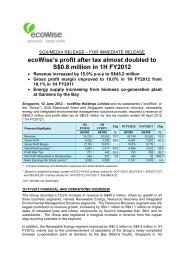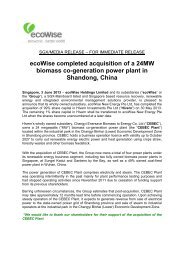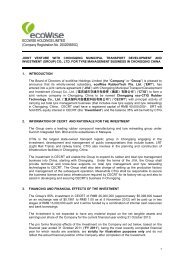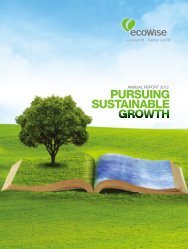Ecowise Annual Report 2007 - ecoWise Holdings Limited
Ecowise Annual Report 2007 - ecoWise Holdings Limited
Ecowise Annual Report 2007 - ecoWise Holdings Limited
Create successful ePaper yourself
Turn your PDF publications into a flip-book with our unique Google optimized e-Paper software.
Notes to FinancialStatements31 October <strong>2007</strong>2. SUMMARY OF SIGNIFICANT ACCOUNTING POLICIES (Cont’d)PROPERTY, PLANT AND EQUIPMENT – Depreciation is provided on a straight-line basis to allocate the gross carryingamounts less their residual values over their estimated useful lives of each part of an item of property, plant andequipment. The annual rates of depreciation are as follows:Leasehold property and improvements – over the remaining lease periodPlant and equipment – 6 2 /3% to 33 1 /3%An asset is depreciated when it is available for use until it is derecognised even if during that period the item is idle.Fully depreciated assets still in use are retained in the financial statements.Property, plant and equipment are carried at cost less any accumulated depreciation and any accumulated impairmentlosses. The gain or loss arising from the derecognition of an item of property, plant and equipment is determined asthe difference between the net disposal proceeds, if any, and the carrying amount of the item and is recognisedin the income statement. The residual value and the useful life of an asset is reviewed at least at each financialyear-end and, if expectations differ from previous estimates, the changes are accounted for as a change in anaccounting estimate, and the depreciation charge for the current and future periods are adjusted.Cost also includes acquisition cost, any cost directly attributable to bringing the asset to the location and conditionnecessary for it to be capable of operating in the manner intended by management. Subsequent cost are recognisedas an asset only when it is probable that future economic benefits associated with the item will flow to the entity andthe cost of the item can be measured reliably. All other repairs and maintenance are charged to the income statementwhen they are incurred.Cost includes the initial estimate of the costs of dismantling and removing the item and restoring the site on whichit is located, the obligation for which an entity incurs either when the item is acquired or as a consequence of havingused the item during a particular period for purposes other than to produce inventories during that period. See Note22 on long-term provisions.IMPAIRMENT OF NON-FINANCIAL ASSETS – At each full year balance sheet date an assessment is made whether thereis any indication that a depreciable or amortisable asset may be impaired. If any such indication exists, an estimateis made of the recoverable amount of the asset. Irrespective of whether there is any indication of impairment, anannual impairment test is performed at the same time every year on an intangible asset with an indefinite usefullife or an intangible asset not yet available for use. The impairment loss is the excess of the carrying amount overthe recoverable amount and is recognised in the income statement unless the relevant asset is carried at a revaluedamount, in which case the impairment loss is treated as a revaluation decrease. The recoverable amount of an assetor a cash-generating unit is the higher of its fair value less costs to sell and its value in use. In assessing valuein use, the estimated future cash flows are discounted to their present value using a pre-tax discount rate thatreflects current market assessments of the time value of money and the risks specific to the asset. For the purposesof assessing impairment, assets are grouped at the lowest levels for which there are separately identifiable cashflows (cash-generating units). At each reporting date non-financial assets other than goodwill with impairment lossrecognised in prior periods are assessed for possible reversal of the impairment. An impairment loss is reversed onlyto the extent that the asset’s carrying amount does not exceed the carrying amount that would have been determined,net of depreciation or amortisation, if no impairment loss had been recognised.48 • <strong>ecoWise</strong> <strong>Holdings</strong> <strong>Limited</strong> • <strong>Annual</strong> <strong>Report</strong> <strong>2007</strong>







